Table of Contents
- Introduction
- Editor’s Choice
- Trampoline Park Market Overview
- Gymnastics and Trampolining Participation Trends
- Participation of Primary and Secondary School Pupils in Trampolining
- Key Causes and Risk Factors of Trampoline-Related Injuries and Fatalities
- Trampoline-Related Injuries by Age, Supervision, and Preventive Measures
- Causes of Trampoline Injury
- Trampoline Injuries – By Type of Injury
- Mechanism of Trampoline Injury
- Location of Trampoline Injury
- Injuries from Garden Play Equipment Among Children
- Trampoline Injuries Among Children: Annual Trends and Risk Factors
- Most Common Trampoline Injury Areas in Children
- Most Common Trampoline Injury Types Among Children
- Trampoline-Related Injuries and Costs by Age Group
- Distribution of Different Types of Trampoline-Related Injuries – By Gender
- Hospital Admitted Trampoline Injuries
- Trampoline-Related Injuries Requiring ED/UCC Care
- Child Safety Risks and Legal Concerns
- Trampoline Injury Claims and Costs Statistics
- Measures Taken for Reducing Trampoline Accidents Statistics
- Recent Developments
- Conclusion
- FAQs
Introduction
Trampoline Accidents Statistics: Trampoline accidents, particularly among children aged 5 to 14, are a growing concern. With around 100,000 emergency room visits annually in the U.S.
The most common injuries include fractures, sprains, and head or neck trauma. With severe cases often resulting from falls or collisions.
Contributing factors include lack of supervision, multiple jumpers, inadequate safety equipment, and improper use.
Safety guidelines such as limiting trampoline use to one jumper at a time. Ensuring proper padding and nets, and supervising children can help reduce risks.
Despite the enjoyment trampolines provide, their potential for serious injury underscores the importance of safety measures and awareness.
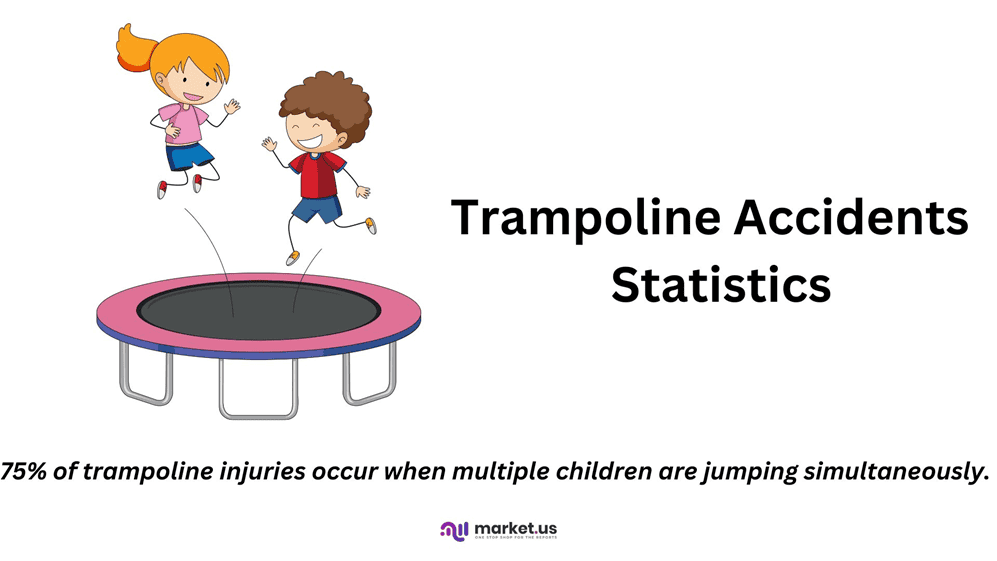
Editor’s Choice
- By 2033, the global trampoline park market size is predicted to reach a value of USD 3,491.5 million.
- 75% of trampoline injuries occur when multiple children are jumping simultaneously.
- The causes of trampoline-related injuries treated at St. Olav’s University Hospital, Trondheim, Norway. Reveal that the majority of injuries, 53%, resulted from awkward landings on the trampoline.
- Trampoline injuries are a big concern for kids, with around 100,000 cases reported each year in the U.S.
- The most common trampoline injury areas in children primarily affect the lower extremities, which account for 36% of all injuries.
- The most common type of trampoline injuries among children are soft tissue injuries, which account for 51.9% of all cases.
- Between 2000 and 2020, a total of 144 patients with trampoline-related injuries were identified in the database at the Emergency Department (ED) of Bern University Hospital Switzerland, with 61.1% being male and 83.3% aged between 16 and 30 years.
- An analysis of hospital-admitted trampoline injuries by gender reveals that males accounted for the majority of cases in Australia, representing 56.2% of total injuries.
- The cost of trampoline-related injuries in New Zealand rose to USD 10,453,794 in 2022.
- In the United States, more than 300,000 people were treated for trampoline injuries in 2018 alone. Highlighting the need for stringent safety protocols.

Trampoline Park Market Overview
Global Trampoline Park Market Size
- The global trampoline park market size is projected to experience substantial growth over the coming decade at a CAGR of 13.90%.
- In 2023, the market is estimated to be valued at USD 950.1 million.
- This upward trend is expected to continue, reaching USD 1,082.2 million in 2024 and USD 1,232.6 million in 2025.
- By 2026, the market size is anticipated to grow to USD 1,403.9 million and further expand to USD 1,599.1 million by 2027.
- Significant growth is forecasted for the late 2020s, with the market size reaching USD 1,821.3 million in 2028 and USD 2,074.5 million by 2029.
- The momentum is expected to carry into the next decade, with the market size projected to achieve USD 2,362.8 million in 2030, USD 2,691.3 million in 2031, and USD 3,065.4 million in 2032.
- By 2033, the market is predicted to reach a value of USD 3,491.5 million. Reflecting a robust and consistent growth trajectory across the forecast period.
(Source: market.us)

Global Trampoline Park Market Size – By Type
2023-2027
- The global trampoline park market is segmented by type into indoor and outdoor categories. It is projected to grow significantly over the next decade.
- In 2023, the total market size is estimated at USD 950.1 million, with indoor trampoline parks dominating at USD 858.89 million. While outdoor parks account for USD 91.21 million.
- This trend continues into 2024, with the total market reaching USD 1,082.2 million. Driven by indoor parks at USD 978.31 million and outdoor parks at USD 103.89 million.
- By 2025, the total market is anticipated to grow to USD 1,232.6 million. Comprising USD 1,114.27 million for indoor parks and USD 118.33 million for outdoor parks.
- Growth is expected to accelerate through 2026, with the total market size reaching USD 1,403.9 million. Including USD 1,269.13 million from indoor parks and USD 134.77 million from outdoor parks.
- By 2027, the market is projected to expand to USD 1,599.1 million. Split between USD 1,445.59 million for indoor parks and USD 153.51 million for outdoor parks.
2028-2033
- This upward trajectory continues in 2028, with the total market reaching USD 1,821.3 million. Fueled by USD 1,646.46 million in indoor parks and USD 174.84 million in outdoor parks.
- In 2029, the total market is forecasted to reach USD 2,074.5 million. With indoor parks contributing USD 1,875.35 million and outdoor parks USD 199.15 million.
- By 2030, the market is expected to achieve USD 2,362.8 million. Supported by USD 2,135.97 million in indoor parks and USD 226.83 million in outdoor parks.
- The growth trend persists through 2031, with the total market estimated at USD 2,691.3 million. Including USD 2,432.94 million from indoor parks and USD 258.36 million from outdoor parks.
- By 2032, the market size is projected to grow to USD 3,065.4 million. Driven by indoor parks at USD 2,771.12 million and outdoor parks at USD 294.28 million.
- Finally, by 2033, the market is expected to reach USD 3,491.5 million, with indoor parks contributing USD 3,156.32 million and outdoor parks USD 335.18 million. Highlighting the steady dominance of indoor trampoline parks in the market landscape.
(Source: market.us)
Take advantage of our unbeatable offer - buy now!


Trampoline Park Market Share – By End-User
- End-users segment the global trampoline park market into two primary categories: adults and children.
- Adults account for the largest share of the market, representing 60.6% of the total market. This dominance reflects the growing popularity of trampoline parks as recreational and fitness destinations for adult users.
- In contrast, children constitute 39.4% of the market share. Highlighting their significant but comparatively smaller role in driving demand within the industry.
- This segmentation underscores the diverse appeal of trampoline parks across different age groups.
(Source: market.us)

Competitive Landscape of Global Trampoline Park Market
- The presence of several prominent players characterizes the competitive landscape of the global trampoline park market in 2022.
- Multiplay International Ltd holds the largest market share at 23%, establishing its strong position in the industry.
- Sky Jumper follows with 14% of the market, while Fun Spot Trampoline and Dreamland Playground Co. Ltd each account for 10%.
- Cheer Amusement captures 9% of the market, and Springfree Trampoline Inc. holds an 8% share.
- Soft Play, LLC, and Super Jumper Inc. each contribute 7% to the market, highlighting their niche but impactful presence.
- Additionally, other key players collectively account for 12% of the market. Indicating a moderately fragmented competitive environment with numerous contributors playing a significant role in shaping the industry’s dynamics.
(Source: market.us)

Global Trampoline Park Market Share – By Region
- In 2022, the global trampoline park market exhibited significant regional variation in market share distribution.
- North America dominated the market with a substantial share of 42.3%. Driven by a strong presence of established parks and high consumer engagement.
- Europe followed as the second-largest market, accounting for 22.8% of the global share. Reflecting steady growth and rising popularity across the region.
- The Asia-Pacific (APAC) region contributed 13.9%, highlighting emerging opportunities in developing economies and increasing urbanization.
- The Middle East and Africa (MEA) accounted for 14.0%, showcasing steady demand supported by growing investments in entertainment infrastructure.
- Meanwhile, South America represented 7.0% of the market, indicating its smaller yet growing presence in the global trampoline park industry.
- This distribution underscores the varying levels of market maturity and growth potential across regions.
(Source: market.us)

Gymnastics and Trampolining Participation Trends
- The number of people participating in gymnastics and trampolining in England experienced significant fluctuations between 2016 and 2021.
- In 2016, participation stood at 269,700 individuals, which increased notably to 315,200 in 2017, marking the highest level during this period.
- However, this upward trend reversed in 2018, with participation declining to 283,500.
- The decline continued into 2019 when the number of participants dropped to 251,200.
- In 2020, participation further decreased to 232,600, reflecting the likely impact of the COVID-19 pandemic and associated restrictions.
- By 2021, the number of participants had fallen sharply to 110,200. Underscoring the substantial disruption caused by the pandemic to recreational activities, including gymnastics and trampolining.
(Source: Statista)

Participation of Primary and Secondary School Pupils in Trampolining
- In 2018, trampolining participation among primary and secondary school pupils in Wales varied by gender and educational level.
- Among primary school pupils, participation was slightly higher for females, with 55.5% engaging in trampolining compared to 53.9% of males.
- In secondary schools, participation levels decreased for both genders but remained higher for females at 43%, compared to 35.6% for males.
- This data highlights that trampolining is popular among both genders in primary schools. Participation tends to decline in secondary schools, with females maintaining a higher engagement rate across both levels.
(Source: Statista)
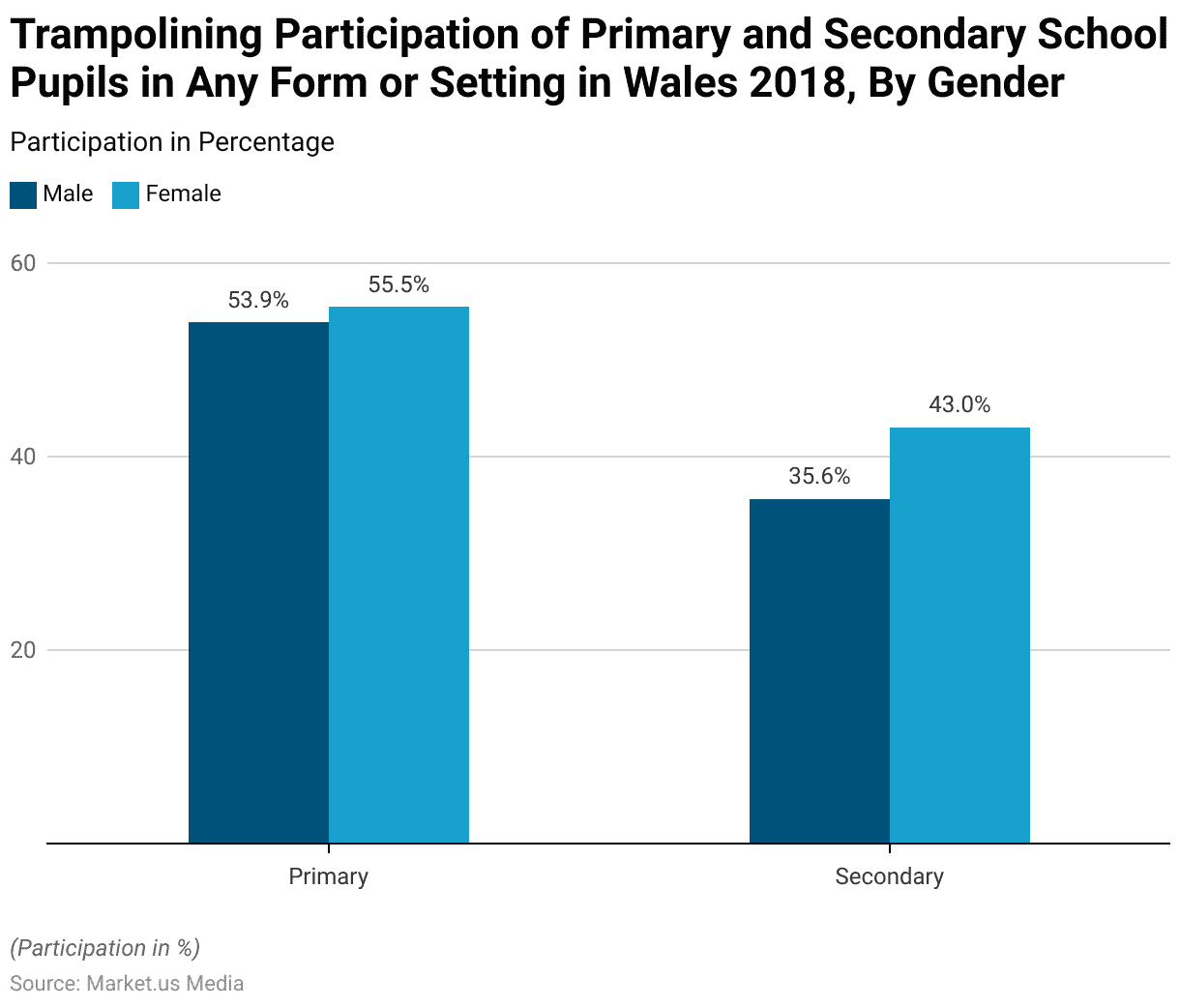
Key Causes and Risk Factors of Trampoline-Related Injuries and Fatalities
- Trampoline injuries and fatalities are primarily caused by four main factors, as identified by the U.S. Consumer Product Safety Commission (CPSC).
- These include collisions with another person, and improper landings while jumping or performing stunts. Falling or jumping off the trampoline, and falling onto the trampoline springs or frame.
- Notably, 75% of trampoline injuries occur when multiple children are jumping simultaneously.
- Falls account for 27% to 39% of trampoline-related injuries. While 20% are caused by direct contact with the springs or frame.
- Young children are especially vulnerable, being 14 times more likely to sustain injuries compared to older children. Underscoring the significant risks associated with trampoline use for younger age groups.
(Sources: U.S. Consumer Product Safety Commission, World Journal of Pediatrics, American Academy of Pediatrics, Cleveland Clinic)
Trampoline-Related Injuries by Age, Supervision, and Preventive Measures
- Between 2001 and 2004, a total of 556 patients were treated for trampoline-related injuries at St Olav’s University Hospital, Trondheim, Norway, representing approximately 3% of all cases in the accident and emergency department.
- Among the injured, 56% were males and 44% were females, with a mean age of 11 years (ranging from 1 to 62 years).
- Age distribution revealed that 13% of patients were aged 1 to 5 years, 40% were 6 to 10 years, 34% were 11 to 15 years, and 13% were older than 15 years.
- Nearly all injuries (554 cases) occurred on regular-sized trampolines, with only two cases reported on mini trampolines.
- Most injuries (77%) occurred on the trampoline itself. Including falls on the mat, collisions with other users, falls on the frame or springs, and injuries during somersaults. In comparison, 22% resulted from falling off the trampoline. In 74% of cases, more than two trampolinists were present on the trampoline at the time of injury, with as many as nine recorded in one instance.
- Adult supervision was reported in 40% of cases overall, and specifically for children under 11 years. Supervision was present in 22% of incidents.
- Preventive measures were recorded in 40% of cases. Including padded trampoline frames in 36% of cases and security nets in 4%.
(Source: National Library of Medicine)
Causes of Trampoline Injury
- The causes of trampoline-related injuries treated at St. Olav’s University Hospital, Trondheim, Norway, reveal that the majority of injuries, 53%, resulted from awkward landings on the trampoline.
- Falling off the trampoline accounted for 22% of injuries, while collisions with another person caused 13%.
- Injuries sustained while performing somersaults constituted 11% of cases.
- Less common causes included other unspecified reasons (1%) and unknown causes (1%).
- These findings highlight the predominance of improper landings and falls as the primary contributors to trampoline-related injuries.
(Source: National Library of Medicine)
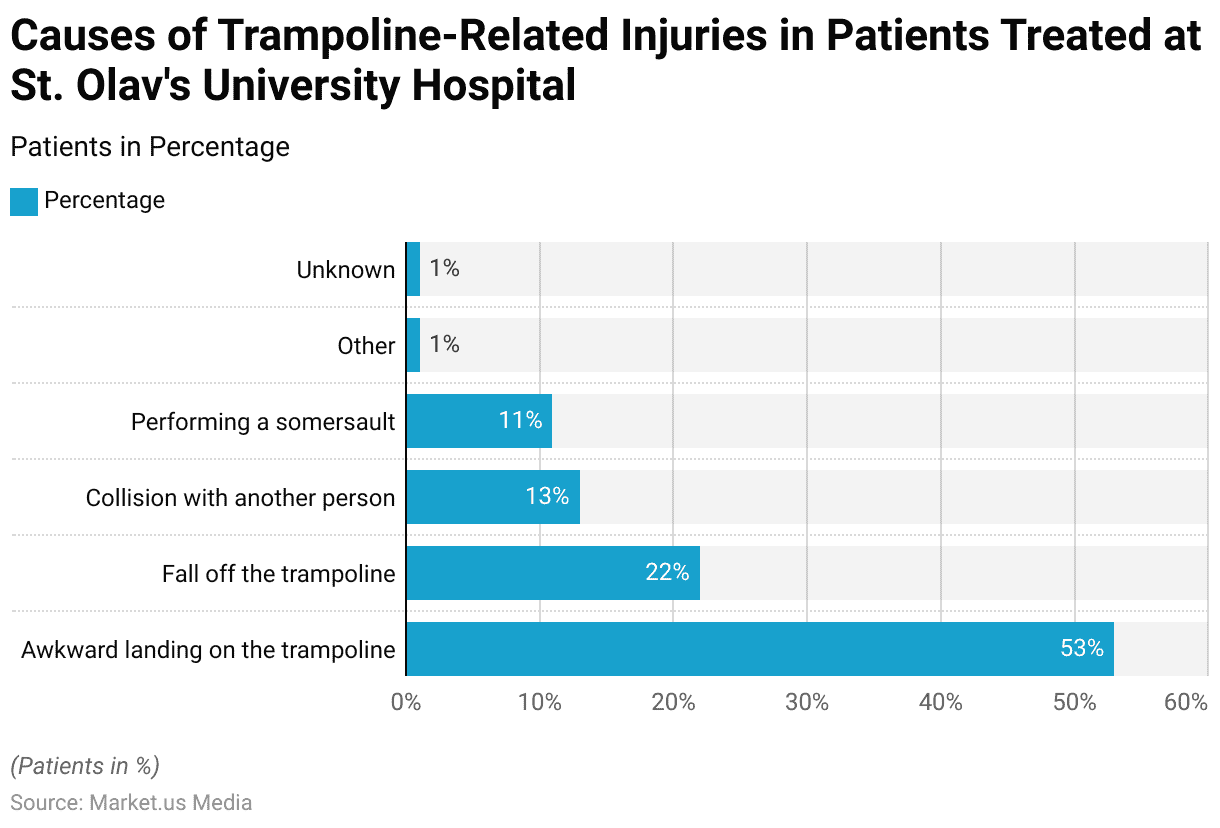
Trampoline Injuries – By Type of Injury
- An analysis of trampoline injuries by type and location highlights key differences between home trampolines and jump parks.
- On home trampolines, 5% of injuries were closed head injuries, and 8% were lacerations.
- Sprains, strains, and contusions made up 43% of injuries. While closed fractures or dislocations accounted for 44%, making them the most common injury type.
- In jump parks, the proportion of sprains, strains, and contusions was slightly higher at 45%. While closed fractures or dislocations were even more prevalent at 53%.
- Additionally, open fractures or dislocations were reported in 2% of injuries at jump parks. While no data was provided for home trampolines in this category.
- These findings highlight the slightly higher prevalence of severe injuries. Such as fractures and dislocations, at jump parks compared to home trampolines.
(Source: American Academy of Orthopaedic Surgeons)

Mechanism of Trampoline Injury
- An analysis of trampoline injury mechanisms reveals differences between home trampolines and jump parks.
- On home trampolines, 59% of injuries occurred during routine jumping or awkward landings. While 16% resulted from falling off the trampoline.
- Injuries from striking the edge, metal bar, or springs accounted for 10%, and collisions with other participants made up 15%.
- At jump parks, the most common cause of injury was also routine jumping or awkward landings. Accounting for an even higher proportion at 74%.
- Falling off the trampoline was not reported for jump parks, but 13% of injuries involved striking the edge, metal bar, or springs, and 8% resulted from collisions with obstacles.
- Collisions with other participants were less common at jump parks, representing only 5% of injuries.
- These findings emphasize that routine jumping is the leading cause of injuries in both settings. Other mechanisms vary in prevalence depending on the trampoline environment.
(Source: American Academy of Orthopaedic Surgeons)

Location of Trampoline Injury
- The distribution of trampoline-related injuries treated at St. Olav’s University Hospital, Trondheim, Norway. Indicates that the ankle was the most frequently injured body part, accounting for 25% of cases.
- Wrist and hand injuries followed at 14%, while the elbow was affected in 11% of patients.
- Head and knee injuries each constituted 9%, and neck injuries accounted for 8%.
- Forearm injuries represented 7%, and foot injuries accounted for 6%.
- Less commonly affected areas included the trunk or back (4%), the leg (3%), and the hip or thigh (2%).
- Injuries to the shoulder and upper arm were rare, each contributing only 1% of the total cases.
- This distribution highlights the prevalence of lower limb injuries, particularly ankle injuries, among trampoline-related incidents.
(Source: National Library of Medicine)

Injuries from Garden Play Equipment Among Children
- In the past year, injuries related to garden play equipment among children have been significant, with an estimated 14.3 million accidents reported overall, accounting for 47% of all childhood accidents.
- Trampolines were responsible for 2.86 million injuries, making up 9% of all childhood accidents, with 37% occurring at another property.
- Swing sets followed closely, causing 2.65 million injuries, also representing 9% of childhood accidents, with 48% taking place at another property.
- Slides accounted for 2.34 million injuries, making up 8% of childhood accidents, with 42% happening at another property.
- Similarly, climbing frames caused 2.45 million injuries (8% of accidents). At the same time, bouncy castles and tree houses were responsible for 2.02 million and 2.00 million injuries, respectively, each contributing 7% of all childhood accidents, with 39% and 38% of these occurring at another property.
- These figures highlight the risks associated with common garden play equipment, particularly when used outside the home.
(Source: Churchill Home Insurance)
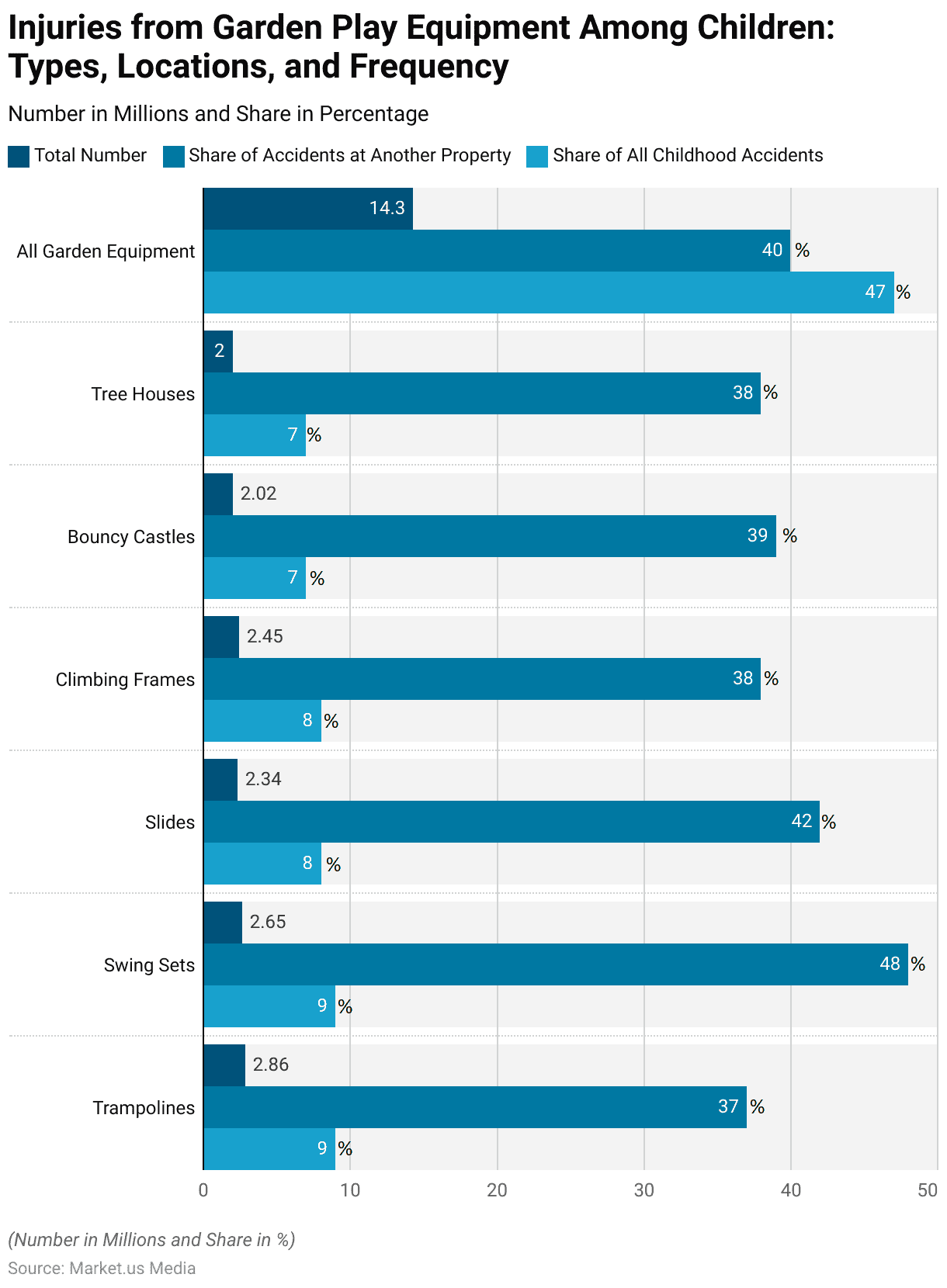
Trampoline Injuries Among Children: Annual Trends and Risk Factors
- Trampoline injuries are a big concern for kids, with around 100,000 cases reported each year in the U.S.
- In 2018, more than 110,000 children went to the emergency room for trampoline-related injuries, according to the U.S. Consumer Product Safety Commission (CPSC).
- Although the exact number of trampoline-related deaths is unclear, at least 22 deaths were reported between 2000 and 2009.
- Most injuries happen when several kids are jumping at the same time, with about 75% of accidents involving more than one jumper.
- Younger kids are at much higher risk, being 14 times more likely to get hurt than older children.
- Injuries are also more common during spring and summer when trampolines are used more often due to warm weather.
- During the COVID-19 lockdowns, trampoline injuries increased even more, as shown in a UK study that linked the rise in accidents after 2019 to more frequent trampoline use at home.
(Source: Belsky & Horowitz)
Most Common Trampoline Injury Areas in Children
- The most common trampoline injury areas in children primarily affect the lower extremities, which account for 36% of all injuries.
- Upper extremity injuries follow closely at 31.8%, reflecting the significant impact on arms and wrists during trampoline use.
- Head injuries constitute 14.5% of cases, while trunk injuries account for 9.8%.
- Neck injuries are less common but still notable, representing 7.9% of trampoline-related injuries in children.
- This data underscores the prevalence of lower limb and upper body injuries during trampoline activities.
(Source: JAMA Pediatrics)
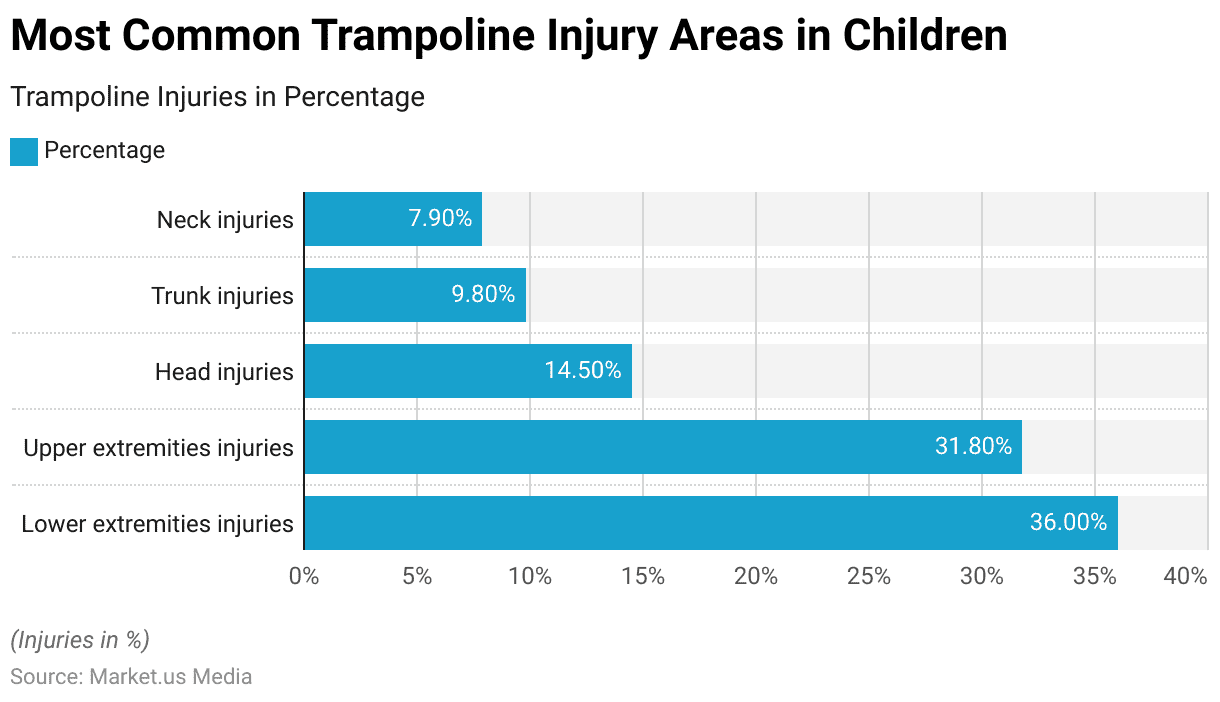
Most Common Trampoline Injury Types Among Children
- The most common type of trampoline injuries among children are soft tissue injuries, which account for 51.9% of all cases.
- These are followed by fractures, representing 34.6% of trampoline-related injuries.
- Lacerations constitute 11.7% of the injuries, making them less frequent but still significant.
- This data highlights the predominance of soft tissue damage and bone fractures as the primary types of injuries sustained during trampoline activities by children.
(Source: JAMA Pediatrics)
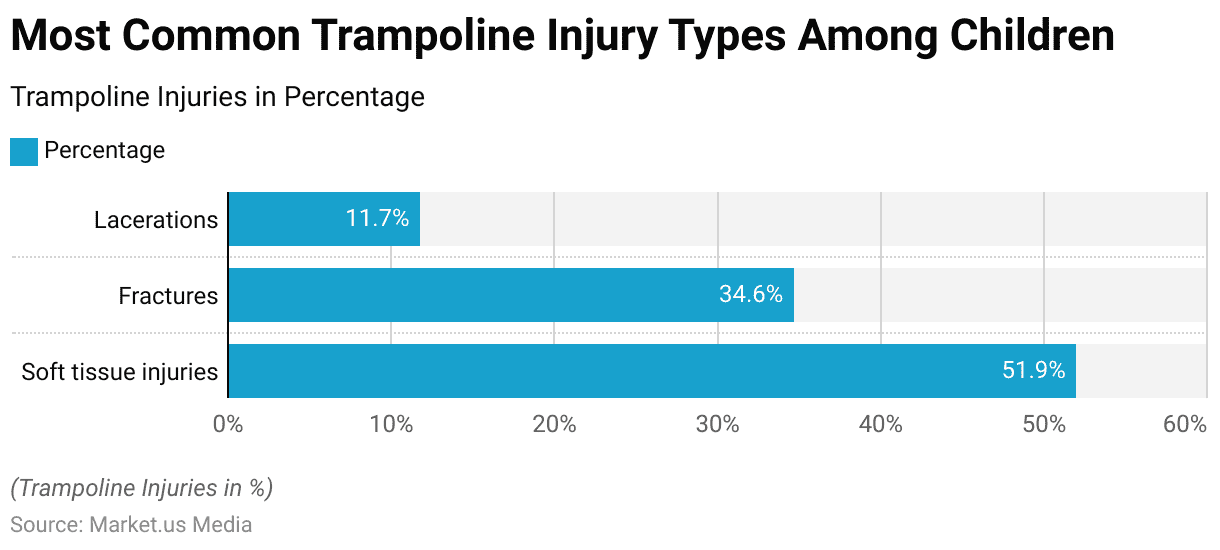
Trampoline-Related Injuries and Costs by Age Group
- Between 2000 and 2020, a total of 144 patients with trampoline-related injuries were identified in the database at the Emergency Department (ED) of Bern University Hospital Switzerland, with 61.1% being male and 83.3% aged between 16 and 30 years.
- Comparisons between younger patients (16 to 30 years) and older patients (31 to 62 years) revealed several significant differences.
- Older patients had a higher BMI, with 25% having a BMI > 25 kg/m². Younger patients were more frequently discharged home following treatment.
- The location of accidents in older patients was more often on private property (29.2%) compared to school sports settings.
- Treatment costs also varied by age group, with older patients incurring higher costs: 41.7% of cases in the older group involved costs between CHF 1001–10,000 compared to 26.7% in the younger group, and 12.5% of cases in the older group exceeded CHF 10,000 compared to 5.8% in the younger group.
- Conversely, the lowest cost category (up to CHF 1000) was dominated by younger patients at 40.8%, compared to 37.5% in the older group.
- These findings highlight key differences in injury outcomes, treatment locations, and associated costs between the two age groups.
(Source: National Library of Medicine)
Distribution of Different Types of Trampoline-Related Injuries – By Gender
- The distribution of trampoline-related injuries by gender, as identified at the Emergency Department of Bern University Hospital, Switzerland, highlights notable differences in injury types.
- Among females, fractures were the most common injury, accounting for 39.3% of cases, followed by sprains at 37.5%, soft tissue lesions at 10.7%, contusions at 8.9%, and traumatic brain injuries at 3.6%.
- In males, sprains were the most prevalent injury type, comprising 43.2% of cases, followed by fractures at 28.4%, soft tissue lesions and contusions at 12.5%, and traumatic brain injuries at 3.4%.
- These findings illustrate gender-specific trends in the nature and frequency of trampoline-related injuries.
(Source: National Library of Medicine)
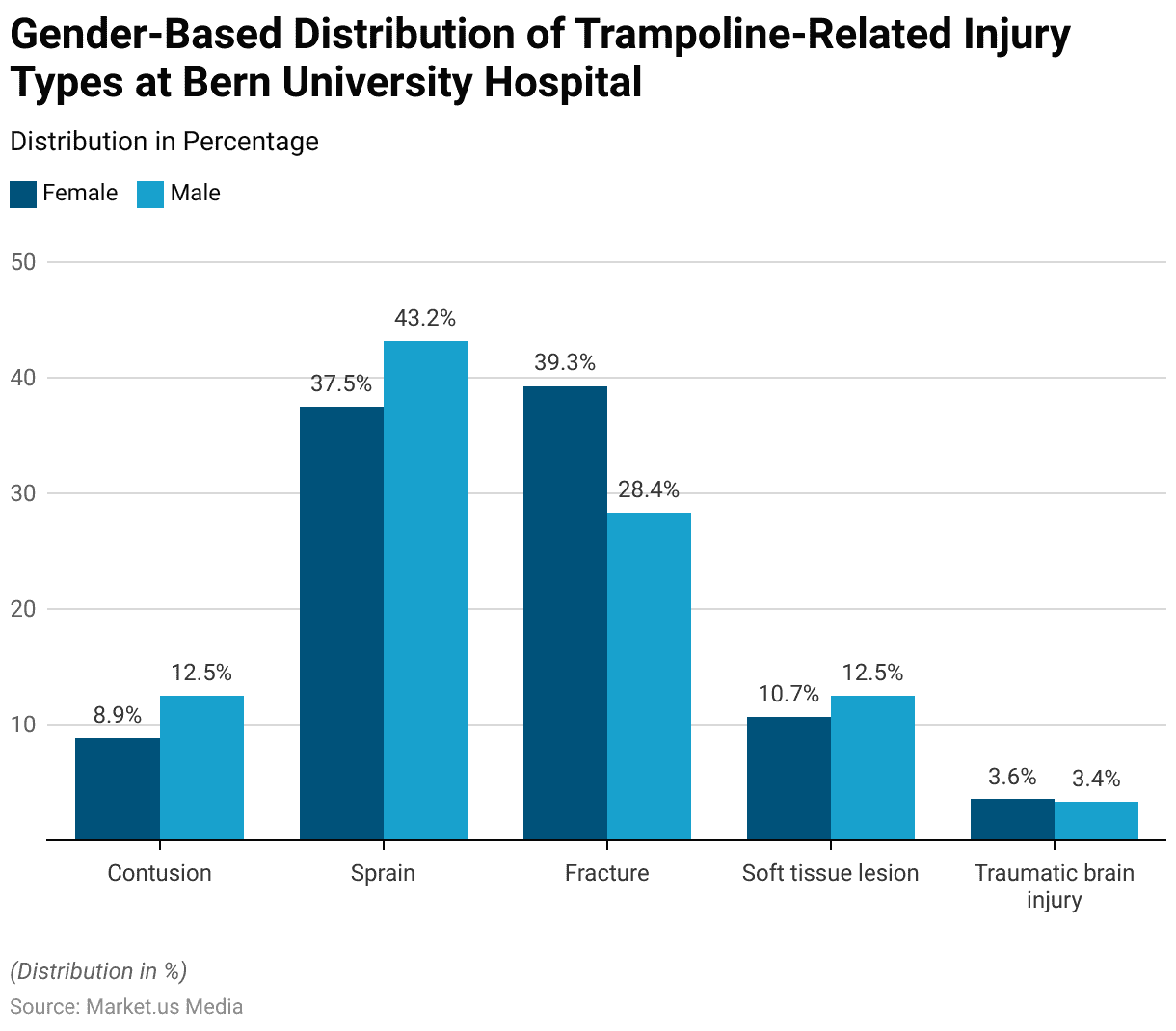
Hospital Admitted Trampoline Injuries
Age
- Between July 1, 2002, and June 30, 2011, trampoline-related hospital admissions in Australia were analyzed by age group, cause, and nature of injury.
- Children aged 5–9 years represented the largest share of admissions, accounting for 46.2% of cases, with falls making up 46.6% of injuries in this group and non-falls contributing 25.4%.
- The 0–4 age group followed, constituting 26% of admissions, where falls accounted for 26.2% and non-falls 16.2%.
- For children aged 10–14 years, 20.8% of admissions were recorded, with non-falls (31.7%) being more prevalent than falls (20.6%).
- Adolescents aged 15–19 years represented 3.3% of admissions, with non-falls making up 13.9% and falls only 3.1%.
- Adults aged 20 years and older accounted for 3.8% of cases, with non-falls at 12.9% and falls at 3.5%.
- These statistics highlight the significant risk of trampoline-related injuries among younger children, particularly those aged 5–9 years, with falls being the primary cause in most age groups.
(Source: Science Direct)
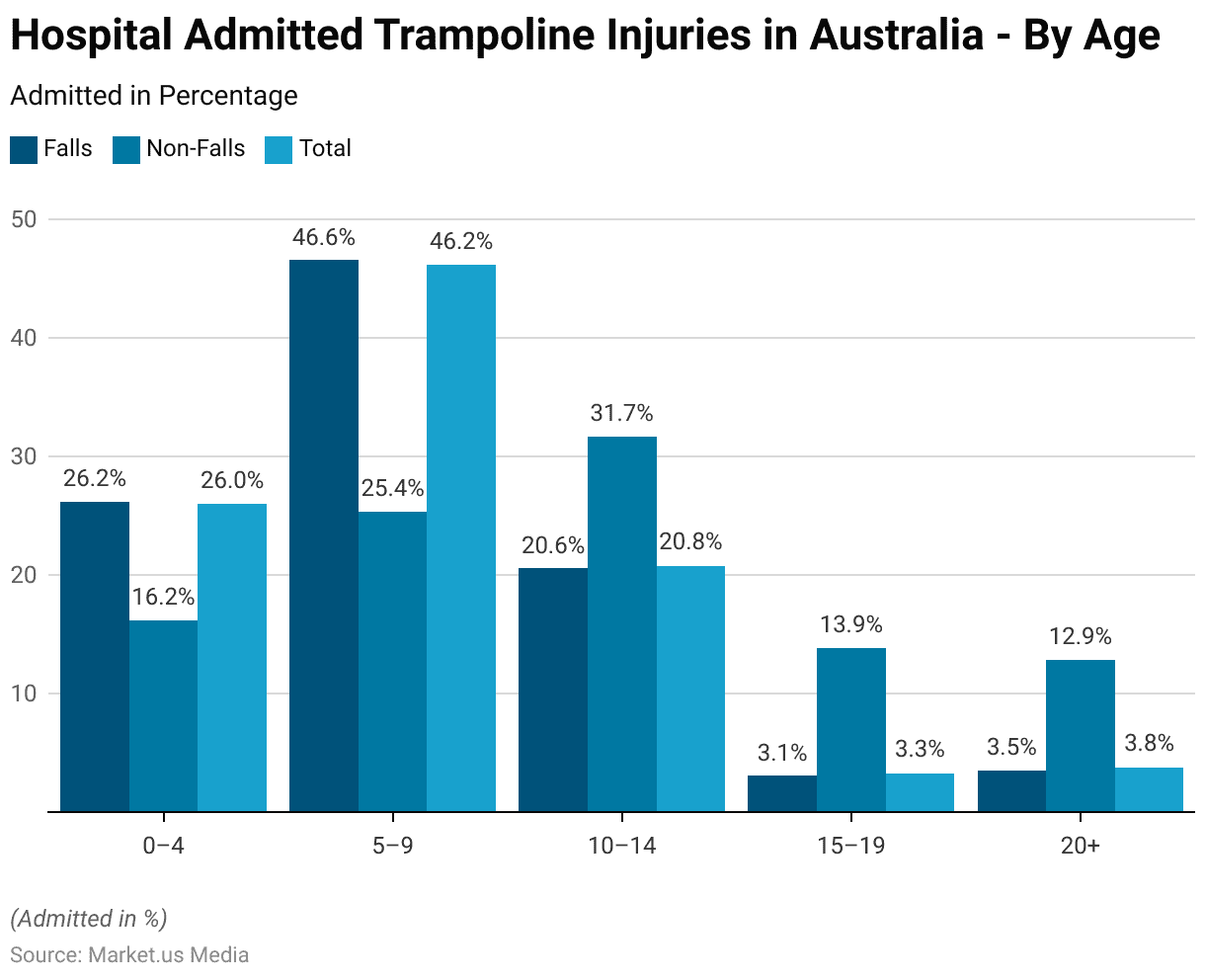
Gender
- An analysis of hospital-admitted trampoline injuries by gender reveals that males accounted for the majority of cases in Australia, representing 56.2% of total injuries.
- Among males, falls contributed to 56% of injuries, while non-fall incidents accounted for 66.7%.
- Females made up 43.8% of total cases, with 44% of injuries resulting from falls and 33.3% from non-fall incidents.
- These figures indicate that males are more frequently involved in trampoline-related injuries, particularly in non-fall scenarios, compared to females.
(Source: Science Direct)

Nature of Main Injury
- An analysis of hospital-admitted trampoline injuries in Australia by the nature of the main injury shows that fractures were the most common, accounting for 80.5% of all cases, with falls contributing to 81% and non-falls 52.1% of these injuries.
- Open wounds made up 4.4% of injuries, with a higher proportion of non-falls (9.6%) compared to falls (4.3%).
- Dislocations, sprains, and strains represented 3.5% of injuries, with non-falls accounting for 14.8% and falls contributing only 3.3%.
- Intracranial injuries were relatively rare, constituting 2.5% of cases, with slightly more from non-falls (3%) than falls (2.5%).
- Superficial injuries also accounted for 1.4% of cases, with non-falls contributing 3%.
- Other and unspecified injuries represented 7.7% of total cases, with non-falls making up 17.5% and falls 7.5%.
- These figures highlight the prevalence of fractures as the primary injury type, particularly from falls, while non-fall incidents result in a wider variety of injury types.
(Source: Science Direct)
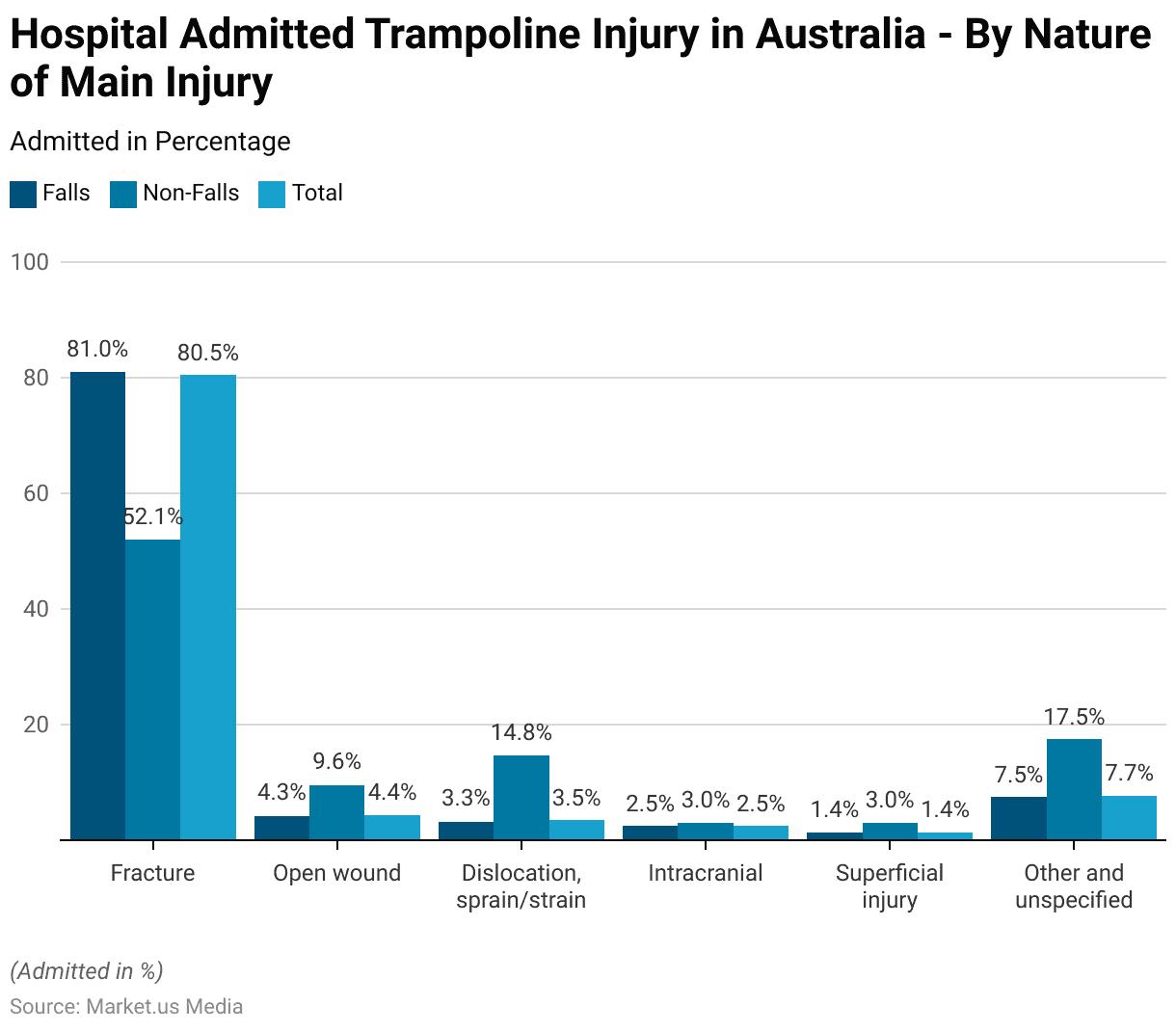
Body Region Injured
- An analysis of hospital-admitted trampoline injuries in Australia by the body region injured shows that the upper limb was the most commonly affected area, accounting for 69.2% of cases, with 70.1% of these resulting from falls and 18.8% from non-fall incidents.
- Lower limb injuries constituted 13.6% of cases, with non-falls (39.3%) contributing more than falls (13.1%).
- Head and face injuries represented 11.2% of cases, with a higher proportion resulting from non-falls (25.2%) compared to falls (10.9%).
- Injuries to the trunk, including the neck, made up 5.9% of cases, with non-falls accounting for 16.2% and falls for 5.6%.
- Other and unspecified injuries were rare, accounting for only 0.2% of cases.
- This data highlights the upper limb as the most frequently injured region, particularly due to falls. At the same time, non-fall incidents tend to result in a wider distribution of injuries across different body regions.
(Source: Science Direct)
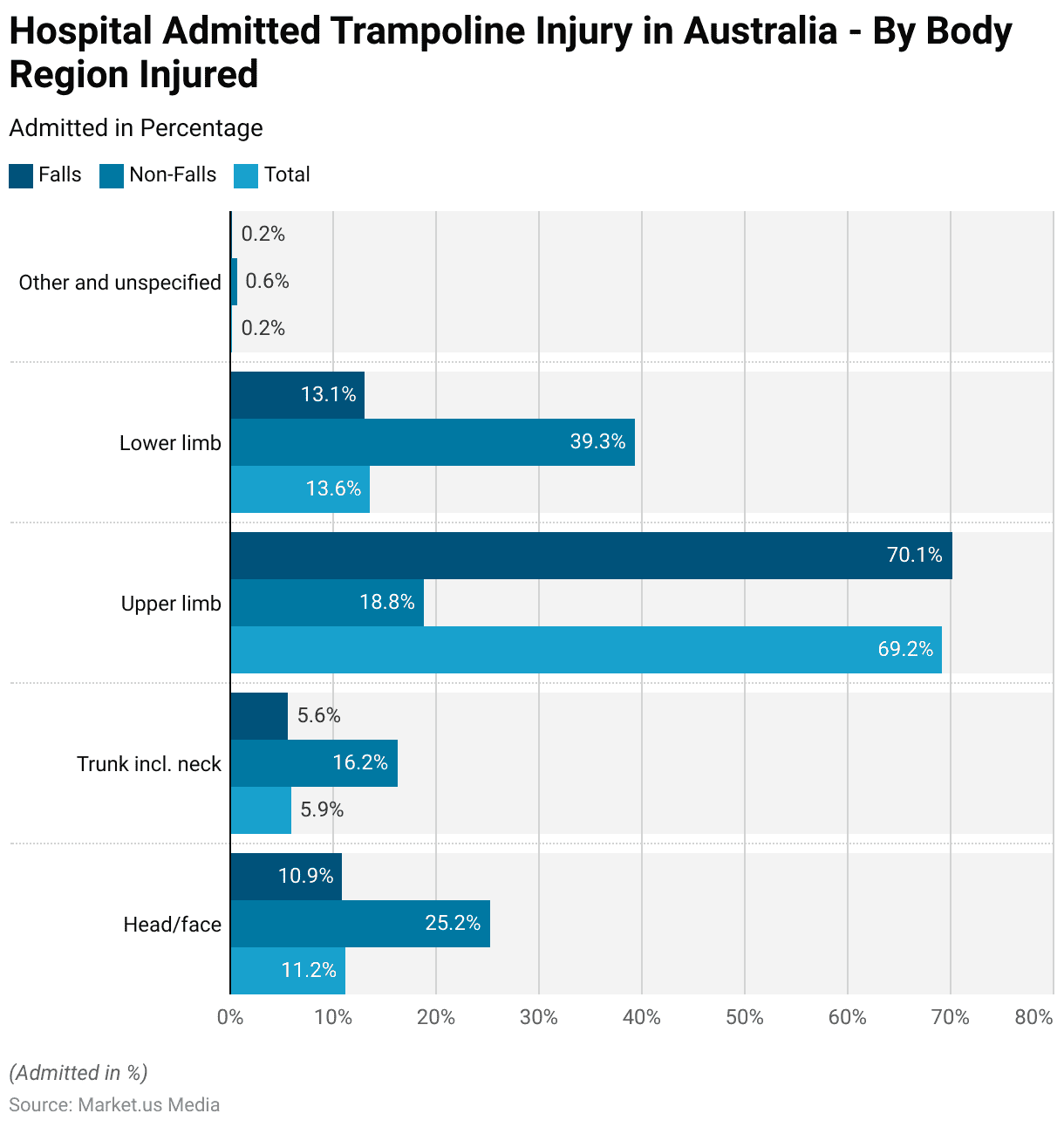
Trampoline-Related Injuries Requiring ED/UCC Care
- In 2021, a total of 1,605 Albertans sustained trampoline-related injuries severe enough to require care in emergency departments or urgent care centers (ED/UCC).
- Among these cases, fractures were the most common injury type, accounting for 40% (642) of injuries, followed by dislocations at 24% (390), superficial injuries at 12.6% (202), open wounds at 5.8% (94), and a rare crushed injury at 0.06% (1).
- Additionally, 17.1% (276) of injuries were classified as unknown.
- The most affected body parts included the knee and lower leg (373 injuries), head (191 injuries), and shoulder and upper arm (149 injuries), while the remaining cases did not specify body parts.
- Children aged 1 to 9 years represented 60% (967) of those injured. Interestingly, less than 30% of injuries resulted from falls off trampolines, highlighting that safety nets, commonly sold with trampolines to prevent such falls, do not effectively reduce overall injury risk.
- This data underscores the prevalence and severity of trampoline-related injuries among children and the limitations of existing safety measures.
(Source: Alberta Health Services)
Child Safety Risks and Legal Concerns
- Recent research by Churchill Home Insurance highlights the injury risks posed to children by garden play equipment, despite British parents spending over £1.36 billion on outdoor play equipment this year, averaging £166 per parent.
- Alarmingly, many parents are not investing in proper safety measures, with 45% admitting they have no protective materials under the equipment.
- Over the past year, 21% of parents reported a child injury, with 19% occurring at home and 14% at another person’s property.
- Garden play equipment, such as trampolines, swings, and slides, accounted for nearly half (47%) of these injuries, while water play equipment and other garden objects contributed to 31% and 22%, respectively.
- Trampolines were responsible for nearly three million accidents, followed by swing sets (2.65 million), slides (2.34 million), and bouncy castles (2.02 million).
- Most injuries were minor, with bruises (42%), sprains (17%), and lacerations (16%) being the most common, but serious injuries like broken limbs (10%) and head injuries (9%) also occurred.
- Additionally, 40% of these accidents happened at another child’s house, equivalent to nearly 5.8 million incidents.
- Lack of supervision contributed significantly, with 43% of parents admitting their child was not monitored the entire time they were playing.
- Legal concerns are also rising, as 16% of parents expressed willingness to sue another parent if their child was injured on their property.
- With 31% of parents reporting their child had been injured at someone else’s house, the potential for litigation is high.
- Furthermore, 22% of parents were unaware they could be sued for an injury occurring on their property.
(Source: Churchill Home Insurance)
Trampoline Injury Claims and Costs Statistics
Claims for Trampoline-related Injuries
- Between 2019 and 2023, the Bay of Plenty region in New Zealand recorded a fluctuating number of new claims for trampoline-related injuries across its districts.
- In 2019, the total number of claims stood at 897, which decreased slightly to 847 in both 2020 and 2021. The numbers further declined to 684 in 2022 before rising again to 697 in 2023.
- Tauranga City consistently reported the highest number of claims, with 494 in 2019, gradually decreasing to 368 in 2023.
- The Rotorua District followed, with claims peaking at 232 in 2020 and reducing to 178 by 2023.
- The Western Bay of Plenty District saw a decline from 87 claims in 2019 to 69 in 2023, while the Whakatane District experienced a similar trend, with claims dropping from 64 in 2019 to 59 in 2023, peaking at 76 in 2021.
- In the smaller districts, Kawerau recorded a significant drop from 15 claims in 2019 to 4 in 2020 before stabilizing at 7 in 2023.
- Opotiki District maintained a relatively steady number of claims, ranging between 16 and 17 during this period.
- These figures highlight a decline in trampoline-related injuries from 2019 to 2022, with a slight increase in 2023.
(Source: New Zealand Herald)
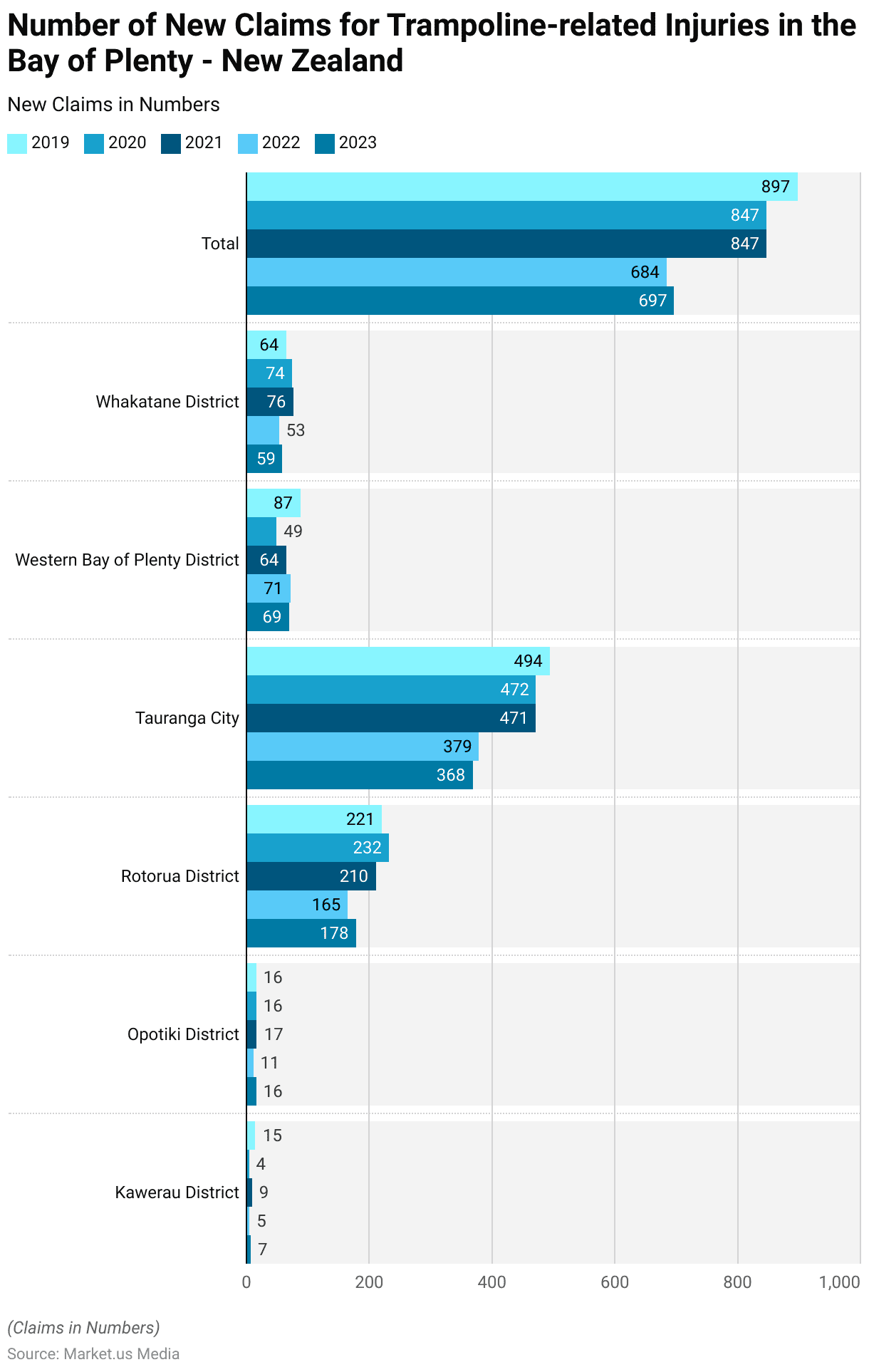
Cost for Trampoline-related Injuries
- Between 2019 and 2023, trampoline-related injuries in New Zealand saw fluctuations in new claims, active claims, and associated costs.
- In 2019, the number of new claims was 12,588, which increased slightly to 12,700 in 2020 before steadily declining to 9,645 by 2023.
- Similarly, active claims followed a downward trend, starting at 13,247 in 2019, peaking at 13,447 in 2020, and reducing to 10,662 by 2023.
- In contrast, the active costs (excluding GST) rose during this period, from USD 9,211,511 in 2019 to a peak of USD 11,314,198 in 2023.
- Notably, the costs fluctuated, increasing to USD 10,659,965 in 2020, dropping slightly to USD 10,292,177 in 2021, and rising again to USD 10,453,794 in 2022.
- This data highlights a consistent decrease in claim numbers over the years while the associated costs have generally increased, reflecting a potential rise in the severity or treatment expenses of trampoline-related injuries.
(Source: Bay of Plenty Times – The New Zealand Herald)

Measures Taken for Reducing Trampoline Accidents Statistics
- In response to growing concerns over trampoline-related injuries, various measures and initiatives have been adopted internationally to enhance safety.
- In the United States, more than 300,000 people were treated for trampoline injuries in 2018 alone, highlighting the need for stringent safety protocols.
- Key measures include ensuring trampolines are equipped with adequate protective padding covering all hard surfaces and springs, installing safety nets (although they should not be solely relied upon for safety), and enforcing strict supervision, especially for children under 14, who are most prone to injuries.
- The American Academy of Orthopaedic Surgeons and the U.S. Consumer Product Safety Commission advocate for these precautions alongside guidelines like permitting only one jumper at a time and avoiding somersaults or high-risk maneuvers without professional supervision.
- In addition to these, regular maintenance, such as checking and tightening trampoline bolts and ensuring the trampoline’s assembly meets safety standards, is recommended to prevent accidents. Professional assembly services are also advised to guarantee that trampolines are set up correctly, thus reducing risks associated with improper installation.
- Such initiatives are crucial as trampoline injuries can range from sprains and fractures to more severe injuries like paralysis, often resulting from falls or improper landing techniques.
- By adopting these safety measures and regularly updating equipment, significant reductions in trampoline-related injuries can be achieved, ensuring a safer recreational environment for users.
(Sources: Livestrong.Com, Aap Publications, Orthoinfo, Aaos, Injury Prevention, Healthier Life Spot)
Recent Developments
Statistics:
- Pediatric Injuries: Between 2009 and 2018, over 800,000 children in the U.S. sustained trampoline-related injuries, with more than 50% occurring at home. Approximately 34% of these injuries were long bone fractures in the lower and upper extremities.
- Annual Emergency Visits: In 2018, trampoline injuries led to over 300,000 medically treated cases in the U.S., including approximately 110,000 emergency room visits. Notably, more than 90% of these injuries involved children aged 5 to 14.
Causes:
- Multiple Jumpers: Over 75% of trampoline injuries occur when multiple individuals are jumping simultaneously, leading to collisions. Falls from the trampoline account for 27% to 39% of injuries, while direct contact with springs or the frame contributes to 20%.
Types:
- Fractures and Dislocations: Fractures constitute 34.6% of trampoline injuries, with the forearm (37%) and elbow (19%) being the most affected areas. Lower extremity fractures are more frequent in females (54%).
Safety Recommendations:
- Supervision and Equipment: The American Academy of Orthopaedic Surgeons emphasizes the importance of adult supervision and the use of safety equipment, such as nets and padding, to mitigate injury risks. They also advise against somersaults and flips due to the high risk of cervical spine injuries.
Conclusion
Trampoline Accidents Statistics – Trampoline accidents are a significant concern, particularly among children, with common injuries including fractures, sprains, and head trauma.
Many incidents occur during routine use or with multiple participants, often due to inadequate supervision or safety measures.
While safety features like nets and padding are marketed to prevent injuries, their effectiveness is limited. Injuries at trampoline parks tend to be more severe, contributing to rising healthcare costs globally.
To reduce these risks, improved supervision, stricter safety guidelines, better equipment design, and education on safe use are essential.
FAQs
Fractures, sprains, strains, head injuries, and dislocations are the most common injuries associated with trampoline use. Minor injuries like bruises and lacerations are also frequent.
Children, particularly those aged 5–9, are at the highest risk of trampoline-related injuries. Younger children are up to 14 times more likely to be injured than older participants.
While safety nets and padding can help reduce the risk of falling off the trampoline, they do not significantly prevent injuries from improper landings, collisions, or multiple jumpers.
Injuries can happen at home, in backyards, or at trampoline parks. Trampoline parks often report higher rates of severe injuries, such as open fractures and dislocations.
Most injuries result from awkward landings, multiple participants jumping at the same time, collisions, and falls off the trampoline. Improper stunts like flips and somersaults also contribute to severe injuries.
Injuries can be minimized with proper supervision, limiting the number of jumpers, using age-appropriate trampolines, ensuring proper maintenance, and educating users on safe jumping practices.
Yes, trampoline injuries can lead to significant healthcare costs due to emergency visits and treatments for severe injuries like fractures and head trauma. Costs have been steadily increasing in many regions.
Trampoline-related deaths are rare but have occurred, often due to severe head or spinal injuries. Proper safety measures can help minimize these risks.
Discuss your needs with our analyst
Please share your requirements with more details so our analyst can check if they can solve your problem(s)



